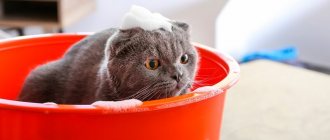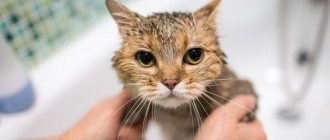6835Administration
With the appearance of a small fluffy miracle in the house, life changes dramatically. Over time, the owners' feelings of tenderness are replaced by questions about how to bathe, feed and care for the kitten. If the last two can be dealt with almost immediately, then the first requires a serious approach.
In order for an adult cat to be calm about the bathing procedure over time, he should be taught this from a young age. But this must be done correctly, following all the rules and recommendations, so as not to cause harm to the animal or cause stress to it.
How to properly bathe a cat for the first time if she is afraid of water
Here's a video of a veterinarian explaining how to bathe a cat.
So, there is nothing complicated in this procedure. The most important thing is not to forget that the cat is stressed and try to complete all the necessary actions as quickly as possible. And remember: the animal will not be afraid of water if you accustom it to it from childhood. By the way, some pets are big fans of swimming.
In this article, we answered the question of whether cats are bathed and told us how many times your four-legged friend should visit the bathroom. Don’t forget that cleanliness is the key to health, and wash your pet correctly.
Massage and exercise
Physical exercises and light gymnastics are prescribed for pets who have hope of recovery. Few people know that disabled pets need a simple 5-minute massage every day. It is completely simple and consists of simply bending the limbs several times. If the cat's owner does not do this, the hind legs will stiffen and interfere with the animal's movement, as well as its ability to assume a normal position while resting.
Massage for disabled animals is the only way to slow down atrophy of the lower limbs. Below are a few more exercises to warm up your muscles:
- after basic flexion/extension of the limbs, you can simply tickle the paws, thereby helping to improve blood circulation in this area;
- massage of the front paws, shoulders and neck - due to the increased load on them, helps to avoid cramps and spasms;
- As a result of the immobility of the hind legs, the animal cannot scratch itself; the owner must take over this function and comb his entire body every day.
How to wash individual parts of the body?
Often, pollution is localized in one part of the body, for example, on the paws or tail. The muzzle and ears are a completely different matter. It is not recommended to wash the entire kitten so as not to disturb the oil balance of the skin. What to do?
Ears
It is recommended to clean dirt in the ears with tampons or sponges. Changing them often, using special means. In extreme cases, vegetable oil or plain warm water will do. At the same time, the kitten is fixed, wrapped as in a diaper.
Ass
Yes, there is such a problem too. The kitten is restrained. You can also hold it under your arm – butt forward. Then gently wipe with damp cotton pads until clean.
muzzle
To wash a grimy pet, fix it and gently moisten the fur with a wet hand, sponge or cloth.
Then, also carefully, in the direction of hair growth, wipe the muzzle with a sponge soaked in foam. After this, the shampoo is thoroughly removed with a wet towel.
Paws
It is correct, of course, to wash dirty paws in water using foam, but often it is enough to simply wipe them with a wet cloth and then dry: firstly, it’s clean, and secondly, it’s psychologically comfortable.
Take care of the appropriate level of convenience, and at what point to organize a regular bath day depends only on the degree of curiosity of your kitten. Be prepared for the fact that the dependence is direct.
How often can cats and kittens be bathed? Regarding this issue, the owners were divided into 2 camps. Some believe that cats themselves are extremely clean animals, and it is not necessary to bathe them, while others are sure that you need to help your pets and maintain their hygiene. This is not to say that any of them are wrong. The truth is somewhere in the middle.
Training aids
Since all owners want to accustom their cat to the litter box quickly and forever, they often begin searching for aids. Special sprays can be good helpers. There are two types of pharmaceuticals:
The principle of operation of the first type of products is based on the fact that their smell attracts the cat, forcing it to go to the toilet in the right place. The secret of this effect is simple: it contains urea, in other words, urea. Therefore, some cat owners do not want to purchase an aerosol; they simply moisten a napkin with the animal’s urine and place it in the right place. But using a spray is much more convenient, and such preparations are inexpensive. The product should be sprayed around the tray: on a piece of paper left nearby, or on the filler itself.
Sprays with a repellent effect are used to treat potentially at-risk areas, such as shoes, places behind furniture, and rugs. It is also recommended to use them in areas where the animal has already left a puddle.
All specialized products are absolutely safe for cats. But there are people who prefer folk remedies, for example, lavender oil. Use a few drops in the place where the animal gets into the habit of going to the toilet - the aroma repels cats well.
Citrus fruits also seem unpleasant to cats - you can leave the peels of oranges or tangerines in the place where the animal has shitted several times.
the washing up
Remember
The first thing to do is to very smoothly place the animal in the water, while holding it very firmly with one hand. After this, wet the coat and apply shampoo to the back, withers, chest, tail and belly. Never allow water to get into your cat's nose or ears. To do this, you can first insert special cotton swabs into your ears.
Particular attention should be paid to soaping the front legs, tail and chin.
Do not forget that various shampoos foam a lot, so you should not apply too much of them, as it will be very difficult to wash off the foam later. To rinse short-haired animals, just one basin will be enough, but if the hair is long, then several basins. After this procedure, you need to thoroughly wipe the cat with a dry towel. In this case, you should not rub the animal under any circumstances; all movements should be smooth and soft, in the direction of the fur. If you wipe against the grain, you can easily damage it. You can also use a hairdryer, but the cat should not be afraid of it. After wrapping the cat in a towel, you need to hold her close to you, but in no case deprive her of support, as she may escape. After water treatments, the cat must be left alone, as it needs to gradually calm down.
Washing cats for participation in various exhibitions
grooming
For routine washing you will need:
– a comb, preferably with wide teeth – 2 or 3 towels or a quiet hairdryer – shampoo – grooming powder
The cat must be washed at least twice. During the second wash, you need to use a special tinted shampoo or balm. You must first wash off the foam with clean water, then with a balm or vinegar solution. This will make combing your fur much easier. When drying, it is recommended to use special massage combs with teeth that are coated with an antistatic coating. You need to wipe the fur dry, starting from the back and gradually moving towards the collar. After this, apply powder to the damp wool. It will not only make the coat silky, but will also absorb all the excess moisture. It is worth noting that the fur should not be left wet, as the pet may catch a cold, and if the fur is long enough, tangles may form. After several hours, it is recommended to treat the wool with a special protein conditioner.
How to wash Burmese cats
Remember, it is strictly not recommended to wash Burmese cats the day before the exhibition, since the hair of this breed is quite thin, and if the shampoo is not selected correctly, your pet will look like a hedgehog. The best option is to carry out this procedure 5 or 7 days before the event. Another very important procedure is ear cleaning. To do this, using cotton swabs, you need to wipe the auricle very carefully. At the same time, remember not to try to get deep, as you can damage your ear. As a rule, cats really like gentle care and, therefore, they will be happy to give you their ears. It is best to carry out this cleaning once a week. It is worth noting that in a healthy cat, sulfur is predominantly odorless and has a fairly light shade. It is also recommended to examine your pet’s oral cavity. If you notice the formation of tartar, bad breath, or discoloration of the gums and teeth, then this is a reason to consult a veterinarian.
And the last procedure that needs to be done is to trim the nails. It should be done like this:
First of all, you need to very carefully release the front paw and squeeze it with your fingers so that the claws protrude forward. The tips of all claws are made of dead tissue and therefore they do not feel pain. Remember, you should never touch the inner pink part, since this is where the blood vessels and nerves are located. That is why, before you start trimming the claws, it is necessary to determine where the blood vessel is located, which cannot be touched in any way.
It is best to trim claws with a special nail clipper, but you can also use regular nail clippers. However, they must be very sharp, otherwise they can split the claw. A very important point is that the claws need to be trimmed as they grow, while the claws on the hind legs, as a rule, are not trimmed.
It is worth noting that after washing, the fur of Burmese cats becomes quite light and soft. All you have to do is brush it thoroughly throughout the remaining time before the exhibition. Remember, the coat must look as natural as possible on the day of the exhibition. There should not be the slightest trace of powder or various liquid care products on it.
How to bathe other breeds correctly?
So, how to bathe a small kitten? The main rule that is recommended to follow when bathing animals of other breeds is to do no harm. Choose shampoos carefully, monitor the water temperature, gently encourage the kitten and soothe it with your voice.
Be careful! Do not put a kitten, like an adult cat, into the water with its head! The head and muzzle can be “wipe” with a damp hand.
How to bathe a baby?
Fill a basin/sink with warm water. Take your pet in your arms and, while talking, stroke him with a wet hand
This will allow the kitten to adapt and mentally prepare for water procedures. Carefully place the kitten into the water. Be careful! Don't jerk your kitten into the water
Do this gradually, but at the same time without delaying too much. The optimal water level is calculated along the chest - the liquid should reach the first or second third of the sternum, but not higher. Make sure the water is not too hot or too cold. While continuing to talk and encourage your pet, begin to wash him with a sponge or hand. If necessary (or if available), apply shampoo to the animal’s fur with gentle massaging movements. Important! You should not use soap, no matter how good it is, or human shampoos (). Rinse the shampoo thoroughly, making sure that the soapy liquid does not get into the kitten's eyes. Dry the animal with a towel and then dry it in any way available to you.
How to properly wash a kitten
The first time swimming is planned on a nice sunny day. The animal must be healthy and fed. Bathing is postponed until the evening, when the kitten is tired from playing, calm and ready to sleep.
- Prepare the bathroom and everything you need: a terry towel, shampoo, a bowl of water.
- Change into home clothes that you don't mind. The kitten may become agitated and accidentally tear it.
- Collect water for bathing. It should be at a comfortable temperature so as not to burn sensitive skin. There should be a couple of centimeters of water in the basin.
- Roll up cotton balls and stick them in the animal's ears. The kitten will not hear any noise, will not be scared, and water will not get into its ears.
- Take the animal by the withers, as a mother cat does, and lower it into the water. The kitten should be comfortable and not in pain.
- Wet the animal's fur, starting from head to tail. If a kitten has fleas, they will not run into the eyes.
- Avoid washing your kitten's hair in the shower to avoid scaring it.
- Apply a few drops of special shampoo and lather, distribute over the animal’s fur.
- Wash the animal using massaging movements.
- Rinse the shampoo in the same direction, from head to tail.
Make sure that the kitten is washed well and there is no foam left on it. Wrap it in a terry towel, leaving an opening for breathing. Gently wipe the fur to remove excess moisture. After a few minutes, release the baby to the sofa, protect it from drafts. You cannot dry your pet with a hairdryer.
Contrary to the various opinions of the Internet community, when asked whether a kitten should be washed and how to wash a kitten, we can safely say that bathing procedures are necessary for babies. How the kitten gets acquainted with the water element will largely determine future views on bathing.
So, how to properly wash a kitten? For washing we need the following:
— A basin of warm water/small sink
How to bathe a kitten correctly?
Why is it better to take your first bath at an early age? A kitten, encountering water procedures for the first time, still does not understand well what shampoo, towel and water are. In addition, a fragile baby has less strength than an adult and strong cat; it will be easier for the owner to hold him.
In order for your pet to perceive taking a bath as a positive and fun event, you need to know how to properly bathe a kitten for the first time. There is no need to involve all family members in bathing; it is better to create a cozy and calm environment for yourself and the kitten. During the procedure, you must stroke and caress the animal so that the baby does not feel fear.
What do you need to prepare?
To bathe a kitten, you need to prepare a small basin. Place a ladle and another container with clean and warm water nearby. You can also bathe your baby in the sink.
To prevent the pet from slipping its paws while washing, place a soft cloth on the bottom of the basin. Bathing accessories - shampoo, conditioner, a clean terry towel - should lie nearby so that they can be quickly reached.
You should take care in advance of having an apron or clothes for the owner, which you won’t mind. If the pet gets scared and starts to break free, its favorite outfit may be flooded with water or damaged by small sharp claws.
What should I wash with?
Wash the kitten in a small container - a basin or baby bath. The container is placed on the bottom of the bath, next to the tap
It is important that the bathroom is warm. The optimal water temperature is 36–39°C.
What detergent is best to use to wash a kitten? Most often, owners purchase special mild shampoos for bathing kittens. Such products foam easily and are quickly washed off with water without causing irritation to the skin.
Human and animal skin differ in composition. You can bathe a kitten with baby soap only in one case - if the pet is very dirty, and there is no special shampoo for animals on hand. Regular use of soap damages the structure of your pet's coat and skin. In some cases, you can use tar soap - it rids the animal of fleas. It is allowed to bathe kittens with this product from 5–6 months and only on the recommendation of a veterinarian.
Shampoo washing process
Basic rules for washing your pet using liquid shampoo:
- You need to lather the detergent before applying it to the coat. It is better to prepare a soap solution in a separate container in advance.
- Distribute the foam carefully using a sponge. Try not to touch your head and ears.
- Rinse the limbs, fingertips, anus and abdomen especially thoroughly. Dirt accumulates faster in these places.
- If you use medicated anti-parasite shampoo for washing, you should lather your neck especially carefully. This will help prevent fleas from moving onto your head.
- Rinse the kitten with clean water from a mug or ladle. It is not advisable to use a tap or shower head so as not to scare the baby.
- Make sure that the shampoo is completely removed from the coat. Otherwise, the kitten may get poisoned when it starts to lick its fur - the not completely washed off product will end up in its stomach.
The kitten should not be immersed in a bowl of water deeper than shoulder-deep, so that the water does not flow into the nose and ears. During the procedure, the baby is calmed down. All actions are performed smoothly and leisurely so as not to scare the animal.
Drying and combing
Immediately after water procedures, a clean kitten is dried with a terry towel, and then wrapped in something dry and soft so that the pet does not catch a cold. After this, the animal must remain in a warm room for at least 12 hours and cannot be allowed outside.
Is it possible to blow dry a cat? If the sound of the device does not cause fear to the animal, you can speed up the drying process with warm air while combing the fur with a special brush. This method is especially suitable for long-haired breeds, whose coat needs to be styled after washing. If a kitten is afraid of a hairdryer and tries to hide, there is no need to force the baby to dry it with a hairdryer.
How to bathe a cat for the first time?
So, we found out that your cat should first become acquainted with water and shampoo at a young age. It should be remembered that a kitten has a vulnerable child’s psyche. The owner’s task is not to instill in the baby a persistent aversion to water and the entire procedure as a whole. To do this, you must follow some rules. The baby’s attitude towards this procedure in the future depends on the very first bath.
A kitten should be accustomed to water from three months. Usually, before this age, his mother washes him out. However, there are exceptions to every rule. If a kitten is very dirty at the age of one month, then it can and should be bathed. You should not carry out the first procedure in the bathroom. A basin is more suitable for this, as it doesn’t look as intimidating to a baby as a huge white bathtub, and it will also be easier to keep him in the water.
You need to pour a little water so that it just reaches the kitten’s tummy. While bathing, talk to your baby in a quiet voice and call him by name. Do not wet the kitten's head from the shower; clean the fur on it with a sponge. Use shampoo for kittens, choosing it based on your pet's coat type. If you can’t purchase it, use any children’s one.
What not to do
Under no circumstances should you punish your pet. If you start poking your animal’s nose into his feces, he will not understand that he is being scolded for going to the toilet in the wrong place; he will simply regard this as a punishment for a completed physiological act. In the future, the cat will hide from you in more secluded places in order to carry out its “dirty deeds”.
You should not forcefully hold your pet in the tray while waiting for him to go to the toilet. The animal will simply get scared and will avoid the tray.
The cat will definitely understand what they want from him - you just need to be affectionate towards your pet. It is not an easy task to accustom an outdoor cat to a litter box, and the result will depend on how you behave. The main key to success is patience; after a certain amount of time, the cat will definitely figure out what to do, and you will find happiness and peace.
Source
Preparing for a swim
First of all, trim the cat's claws, this will protect your hands from deep and rather painful scratches. Brush the fur a little to prevent it from becoming too tangled during bathing.
This is especially important for long-haired animals. All matted wool is cut off if it cannot be untangled
If a small amount of water is enough to bathe a kitten and you can get by with a basin, then what about an adult animal, which can sometimes be quite impressive in size? Keeping it in a small container is much more difficult; besides, it costs nothing for an adult and strong cat to turn the basin over. How to bathe a cat in the bathroom so that he doesn’t run away during a procedure he hates so much?
The first thing you need to do is protect your pet's ears. To prevent water from getting into them, put a cellophane cap on his head. Place a terry towel on the bottom of the bath so that your pet does not slip and feels at least a little more confident. There should be enough water so that it is just above the animal’s belly.
When starting to bathe your cat, turn off the water, as its noise additionally frightens the cat. Another important factor is water temperature. It should be slightly warm. Dip your elbow into it - it should not burn your skin. When bathing a one-year-old cat for the first time, you expose him to enormous stress, which will be very difficult for one person to cope with. In this case, at least two people will be able to hold it, since the frightened animal screams, breaks out, and scratches. It’s better to do this together, then one person holds the cat and the other washes it.
If you know your pet is too nervous, bathing becomes an additional challenge. In this case, how to bathe the cat? At this moment he scratches and even bites mercilessly. In this case, veterinarians recommend giving him a special cat sedative before the procedure. However, you should not abuse it.
Causes of discharge from the anus
Discharge in a cat during diarrhea or constipation is quite normal and quite common. They manifest themselves in different ways, but are fairly easy to identify, so they are not too dangerous. The owner may also notice a small amount of blood clots in them. This symptom disappears completely with complete recovery. Therefore, you should not worry too much about this.
But if the discharge from either the anus in a cat or the vaginal area in a cat is purulent or mucous in nature and has a characteristic odor, we can talk about the presence of an infection.
Often this can be associated with problems with the genital organs of cats. But there are other options that require careful testing, special tests and smears. Here you should seek the help of a specialist as soon as possible so as not to aggravate the situation and alleviate the cat’s suffering.
© shutterstock
Often the cause of discharge from the anus is inflammation of the paraanal glands. Previously, many were inclined to think that such problems were directly related to the abundant use of dry food in the diet of pets. However, it turned out that this is a myth. Often, discharge appears due to the unusual structure of the intestine itself . For example, you may notice frequent attempts by the animal to sit on its hind legs or walk along the floor. Such manifestations of attempts to get rid of excess secretions should be immediately noticeable to the owner.
Winter time
During the cold season, felinologists generally do not recommend subjecting your pet to water procedures. The fact is that an animal can catch a cold as a result of hypothermia and get sick. You need to be especially careful to prevent the occurrence of certain ailments. In winter, cats like to be warmer. For this reason, dry, thick fur can retain heat. If after washing the animal is in a draft, then it is unlikely that it will be possible to avoid health problems in the future. It is necessary to take care of your four-legged friend and try to foresee the consequences of your actions in advance.
Problems with bowel movements
Depending on how damaged the spinal cord was, defecation processes are disrupted. For example:
- in disabled cats, food begins to move through the intestines more slowly than usual;
- there is a disruption of the rectal sphincter;
- loss of impulses when the rectum is full, as a result the animal does not strain the abdominal wall, and the sphincter remains in a compressed state;
- in rare cases, fecal incontinence.
To prevent unpredictable independent defecation, when feces fall out while the animal moves around the apartment, you need to take control of this process. To do this, it is necessary to stimulate the animal's sphincter with a finger, thereby causing a reflex emptying of the rectum.
The main thing is that the pet goes to the toilet “in a big way” at least once every two days, and that the feces themselves are soft.
Indications for washing cats
Of course, sometimes there are cases when washing animals is indispensable. An inquisitive cat sticks its nose everywhere and can get dirty with paint, other chemicals, roll in the dirt, or worse, in manure. In these cases, the animal must be washed to avoid complications from chemicals or simply to protect its home from dirt, sometimes with an unpleasant odor. After bathing, the cat should be wrapped in a warm towel and ensure that it does not get into drafts or run out into the street.
The coat of cats that take part in exhibitions must have the proper appearance. Breeders of purebred beauties know how to care for the coat, alternating bathing with dry brushing. They always bathe their pets with special products to improve the quality and shine of their coat. But even in these cases, this happens within a few days so that the coat has time to restore its natural protective barrier.
Anti-flea prevention also includes mandatory washing of cats. Although today, in addition to flea shampoos, there are enough other products that do not require water procedures: drops, collars. If shampoo is still the most suitable option in a particular case, then veterinarians advise washing the animal no more than once a month.
When should you wash your cat?
There can be several reasons for bathing cats. Let's look at each of them in more detail.
The appearance of a kitten in the house
If the kitten was adopted from a shelter or from a domestic cat, then it is absolutely not necessary to wash it, because in these cases it must be clean. If a kitten is picked up on the street, you definitely need to give it a bath. In this case, it is necessary, for preventive purposes, to use special shampoos. This will not only keep it clean, but will also help identify possible skin problems.
that will need to be cured.
If the cat gets dirty
Not all cats are absolute cleanliness. Some can only lick the sides
or wipe your head with your paw, leaving areas such as:
- tail;
- butt;
Therefore, the owners themselves finish what they started, giving the cat a good bath.
Also, walking cats can get dirty with dirt, dust, and bring home burrs and cobwebs on their fur. To prevent all this stuff from ending up on upholstered furniture or a bed, the animal must be bathed. Even indoor cats that never go outside can get dirty by turning over a pot of soil, carelessly going to relieve themselves, and so on.
Animal molt
Many breeds are artificially bred, so owners must take special care of them. Animals are bathed in order to soften the skin and fur, which dry out very strongly in a heated room.
If your cat has fleas, you can wash it with flea shampoo. Some of them do not cope with this task and, in order not to wash your pet often because of this, you can use stronger products
in the form of drops or sprays. They are applied to the animal’s fur and washed off after two days.
There are also veterinary shampoos with tar that treat skin diseases in animals. It should be used only as prescribed by a doctor.
Preparation for the exhibition
Elite purebred cats require appropriate care. Before various exhibitions they are washed with special shampoos.
, adding shine to the coat and increasing its volume. Such shampoos are very expensive, but the wool looks great.
These are the reasons why animals are bathed. But don't get too carried away with it. Many owners wash their pets on purpose to make fun of their pitiful wet appearance. Such careless pet owners should know that they do not have sweat glands
, and the amount of secretion secreted by the sebaceous glands protects against dryness. If you bathe your cat too often, the water begins to wash away the secretions and the skin becomes dry. It becomes covered with cracks, peels off, and the hair begins to fall out.
Moving around the apartment
With irreversible changes in the spinal cord, some cats can move around the apartment with a spinal gait, i.e. The hind legs walk reflexively and are not controlled by the brain. Of course, the back half of the cat moves awkwardly, with a strong amplitude, but this is not so important, because the pet walks on its own. With a spinal gait, the hind legs are rarely injured, but cat owners should be on the alert, and if abrasions are detected, they should put socks on the paws.
If this gait does not work out for your pet, it will still move deftly and quickly on its forelimbs. Advice to all owners of disabled cats - do not help their pets move. Don't do the animal a disservice. If you see that your pet is trying to climb onto the sofa, do not interfere. Let him do it himself, without outside help. This is the only way to achieve active behavior and the development of new skills in paralyzed cats.
It is extremely important to play with a disabled cat as with a normal pet. You can equip a multi-tiered house through which the animal will move and crawl.
Some owners buy a walker or stroller for their four-legged friend. These devices are mainly needed by dogs, but they are also used for cats. You can put a walker on your pet during active games. But during rest it is better to take them off. In general, everything here is individual. Some cats happily accept strollers and walkers, while some, on the contrary, do not allow them to be put on.











